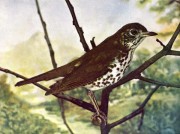The boy and I took the dogs into the town park late in the morning. Today is supposed to be the last day of a rather brutal heat wave, so none of us has been getting much exercise.
Other than the catbirds rustling in the bush, the only visible fauna out on the paths in the sun were tiger swallowtail and red-spotted purple butterflies. I did see a male black swallowtail and another that I was never able to get a look at because it never came to a rest. It had an unusual flying technique that seemed more concentrated and deliberate than the random, jerky, open-air glides of the other butterflies, always remaining only inches above the leaves and branches it was flying over, but too fast and chaotic to let the eye fix on it.
Passing by some likely high, dense bushes, I told the boy that I’d see if anyone would come out to visit, and I played a yellow warbler song. A common yellowthroat hopped out on a limb a few feet above and six or so feet down the path and sang to us for a while. It was about then that we realized that we had not seen the dogs for a while. I called for them, and the puppy came. I followed her back to the older dog, which was nosing around the carcass of a yearling deer folded up a few feet into the bushes at the edge of the path.
We were at that time coming out of the back trails in the fields that are cut through the brush and mowed despite being rarely used. This was clearly to our advantage, as the blackberries are just coming into season. Only a few at each branch were ripe, but the bushes were untouched. The berries we picked were still a little tart, but already soft, sweet, and flavorful. At least they were to me. The boy found them still too tart to be fully enjoyed.
Myself, I’d been experiencing some diverticulitis lately which I had suspected was from getting blueberry seeds lodged in my colon – I’ve been eating blueberries by the handful the last few weeks, and who wouldn’t. So I was a little apprehensive about the seeds from the blackberries, which are larger and harder. I tried to chew them down as much as possible, or even spit them out when I could. Growing old is not going to be a picnic.
I reflected that my age metaphorically is not that unlike the current point of the season with some good bit of heat remaining before the fall. Past the peak and full force youth. I am feeling a little bit dried-out and bug-eaten like the leaves are now, and slowed down a a little too as I might be from the heat and humidity. But that is about as far as I’m going to carry it.
We can expect only one point of comparison from our analogies, the one that allows us to make them. If we gain a second by the act of making it, that might be considered unexpected wisdom and we should be grateful for it. But we never learn anything by actively seeking additional points of comparison.


